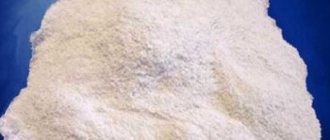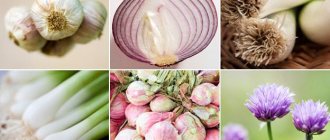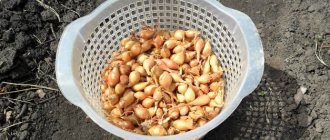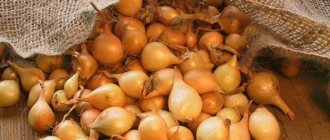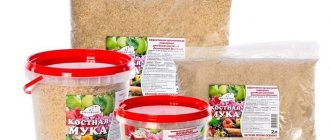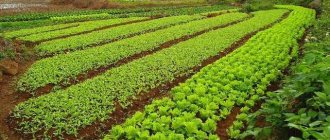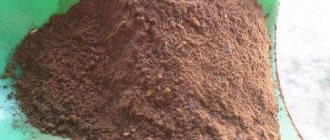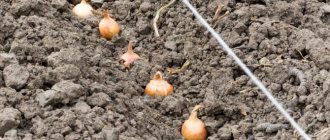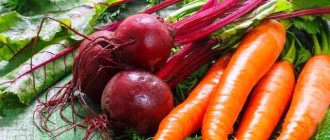Benefits of using ash as fertilizer for onions
Wood ash is a valuable mineral fertilizer. It contains up to 30 micro- and macroelements that are necessary for the growth of garden crops. Ash completely replaces phosphorus-potassium mineral fertilizers, since it contains potassium and phosphorus in large quantities.
100 g of wood ash contains up to 25 g of calcium, 8 g of potassium and 3 g of phosphorus.
There are two types of ash: vegetable and wood. Onions need phosphorus and potassium, so hardwood wood ash and straw ash are suitable fertilizers. Ash composition in the table.
| Type of ash | Compound | Share, % |
| Made from rye straw | Calcium | 8 |
| Potassium | 16 | |
| Phosphorus | 5 | |
| Made from wheat straw | Calcium | 6 |
| Potassium | 14 | |
| Phosphorus | 6 | |
| From birch firewood | Calcium | 40 |
| Potassium | 5-6 | |
| Phosphorus | 12-13 | |
| From sunflower stems | Calcium | 18 |
| Potassium | 36 | |
| Phosphorus | 3 |
In addition to the main components, ash contains manganese, copper, zinc and other substances. The composition of the ash depends on what residues it was obtained from. Wood ash, obtained from deciduous trees, such as birch, is suitable for onions. It contains the most potassium. Advantages of ash over other fertilizers:
- Improves soil structure, increases the content of vermicompost in the soil and accelerates the rotting of plant residues.
- Phosphorus and potassium are in a form accessible to plants and are quickly absorbed.
- The ash contains no chlorine.
- Suitable for almost all types of soils: acidic, neutral and others. For alkali soils, use with caution, depending on the pH of the soil, since ash is alkaline and can harm crops in alkaline soil.
- Increases onion resistance to drought and temperature changes.
- Protects against pests. Ash makes onion leaves elastic, so aphids do not damage them.
- Improves the preservation of onions, the crop does not rot.
- Reduces soil acidity. Ash is used as an independent fertilizer and as a component of fertilizing.
What and how to feed onions
Methods of fertilizing onions
:
- The first and most popular is organic fertilizers such as manure, humus, compost, ash and peat.
- The second most popular method is complex mineral fertilizers. Such fertilizers contain 2 or 3 main components, and may also contain microelements.
- Third way. Feeding onions with mineral fertilizers that contain only one element. For example, urea.
- Fourth way. Folk remedies.
On a note!
You can feed both at the root (root feeding) and by spraying on the leaf (foliar feeding). Let's look at the circumstances.
Read all about growing onions in this article.
Comparison of ash with purchased products
Ash cannot be compared with any purchased mineral fertilizer. It contains up to 30 elements, but does not contain nitrogen. The main components of ash are potassium, phosphorus and calcium. Potassium forms the basis of such products:
- potassium chloride;
- potassium salt;
- potassium sulfate.
In addition to these products, ash replaces granulated superphosphate and lime. 0.5 kg of ash replaces 110 g of superphosphate, 250 g of lime and 120 g of potassium chloride. Ash with urea replaces the Agricola-2 fertilizer for onions and garlic, which is used for the second feeding of onions. Feed at the stage of bulb formation with an interval of 7-10 days. “Agriokla-2”, unlike ash, contains a specially selected complex of nitrogen, phosphorus, potassium and magnesium for growing onions. [wp-svg-icons icon=”file-word” wrap=”i”] Read reviews from gardeners about Agricola fertilizer
For onions, the fertilizer “Agricola Aqua Vegeta” is used. Fertilizer, like ash, is suitable for root and foliar feeding. It is applied at intervals of 10-15 days. For onions, Effekton-O fertilizer is also used. This drug is intended to increase onion yields and accelerate fruit formation. Acidity pH=6.5-7.
Adding fertilizer to the hole when planting onions
If for some reason it was not possible to prepare a place for onions in advance, then you need to have time to do this at least two weeks before planting. As a last resort, fertilizers are applied directly to the hole during planting:
- wood ash - 5–6 g;
- superphosphate - 3-4 g;
- crushed humus or compost - 10–15 g.
Fertilizers, in particular wood ash, can be applied directly during planting
As a preventive measure to combat onion flies, it is recommended to pour a little (3-4 g) of ordinary table salt into each row or hole.
Video: fertilize onions when planting
Fertilizers with ash for onions
If you do not have the opportunity to prepare ash yourself, you can always purchase it at the store. List of manufacturers with prices in the table.
| Name | Description | Cost, rub. |
| Wood ash "Vitaflor" | The composition includes ash from deciduous trees. Weight 5 kg | 425 |
| Wood ash “Healthy Garden” | Suitable for soil deoxidation and for growing seedlings. Improves the keeping quality of fruits and increases the frost resistance of plants. For 1 sq.m. will use 50 g of product. Weight 1 kg. | 156 |
| Wood ash "Vermion" | The composition includes ash from deciduous trees. Weight 1 l. | 40 |
| Wood ash “Look to the root” | Suitable for soil deoxidation. Weight 0.7 l. To deoxidize the soil, add 0.7-1.5 kg per 1 sq. m. | 39 |
Using ash in the garden
When feeding vegetables with ash, the first thing you need to consider is the acidity level of the soil. Alkaline soil is not fertilized with ash, because this will lead to even greater alkalization. But adding ash to acidic soil makes its reaction close to neutral.
Feeding seedlings with ash
To speed up the growth of seedlings, they need to be pollinated with a thin layer of ash every 8-10 days. This procedure will also protect the plants from pests. When 2-3 true leaves appear on the plants, they should be dusted with a mixture of ash and tobacco dust (in equal proportions). This way you will scare away the cabbage fly, cruciferous flea beetle and other insects from the seedlings.
Also, when planting seedlings in the ground, 1-2 tablespoons must be added to each hole. dry ash. This fertilizing will fertilize the soil and help the plants take root better.
Ash can also be scattered around plants and between rows.
Feeding plants with ash in a greenhouse
Ash solution is most often used for watering vegetables (primarily cucumbers) grown in a greenhouse. In protected soil, root feeding is usually carried out: 0.5-1 liters of liquid ash fertilizer are used per plant.
Feeding cucumbers with ash
Cucumbers experience a particular deficiency of potassium and calcium during the formation of ovaries. Therefore, in order to improve the ripening of fruits, at the beginning of flowering, the plants are watered with an infusion of ash (0.5 liters for each bush). Fertilizing is repeated every 10 days.
Cucumbers grown in open ground are additionally fed by foliar feeding: they are sprayed with ash decoction so that the entire leaf plate is covered with a gray coating. During the period of active growth and budding, 3-4 feedings are carried out per month.
Fertilizing tomatoes and peppers with ash
When growing tomatoes and peppers, add 3 cups of ash per 1 sq.m while digging the soil, and when planting seedlings of these crops, add a handful into each hole. Ash can also be applied to peppers and tomatoes throughout the growing season. Before each watering, the soil under the bushes is sprinkled with ash, and after moistening the soil is loosened.
Top dressing of onion and garlic with ash
When digging in autumn, add 2 cups of ash per sq.m. to the soil for onions and garlic, and 1 cup per sq.m. in spring. These crops are prone to root rot, and adding wood ash to the soil prevents the growth of putrefactive bacteria.
You can also feed onions and garlic with infusion of ash at the root or water the grooves with it. But this is done no more than three times per season.
Fertilizing potatoes with ash
When planting potatoes, add 2 tablespoons under the tuber into each hole. ash. When digging the soil, use 1 cup of ash per sq.m. During the growing season, when the potatoes are first hilled, 1-2 tablespoons are added to each bush. ash, and during the second hilling (at the beginning of budding) the rate is increased to 1/2 cup per bush. It is also useful to spray the leaves with ash decoction.
When planting, you can sprinkle ash on the potato tubers themselves - this will protect them from wireworms.
Feeding cabbage with ash
When digging up cabbage of different types, add 1-2 cups of ash per square meter, and when planting seedlings - a handful in each hole. Ash also perfectly protects representatives of the Cruciferous family from pests: plants are sprayed with infusion on the leaves. The number of treatments depends on weather conditions: if it rains, the leaves need to be pollinated more often.
Fertilizing carrots and beets with ash
Before sowing these crops, 1 cup of ash per sq.m. is incorporated into the soil. After germination, it is necessary to sprinkle the carrot and beet beds with ash once a week before watering the plants.
Feeding zucchini with ash
Under the zucchini add 1 cup of ash per 1 sq.m while digging the soil, 1-2 tbsp. – in each hole when planting seedlings, and on depleted soils during the growing season, additionally fertilize the plants during watering: use 1 cup of ash per sq.m.
Features of feeding onions with ash
The ash is used to feed onions and spring onions. They begin to feed after greenery appears. Let's consider in the table the differences in fertilizing depending on the type of onion.
| Deadlines | Onion | Bow on feather |
| First feeding | Feed 2 weeks after planting the seedling. Onions need nitrogen, so nitrogen fertilizers are used. Manure or bird droppings will do. | Feed onions once, 2 weeks after sowing. Complex mineral fertilizers are applied that contain nitrogen, phosphorus and potassium. You can feed the first time with nitrogen fertilizer, for example, ammonium nitrate, and after a week, water the onions with an infusion of ash. |
| Second feeding | Feed one month after the first. Onions need nitrogen, phosphorus and potassium. You can combine ash with urea. | |
| Third feeding | Feed when the bulb is formed. Onions need phosphorus and potassium in large quantities. |
Nitrogen is important for onions, which contributes to the growth of green mass; it is impossible to do without nitrogen fertilizers. The soil for planting onions is prepared in the fall. When digging 1 sq.m. add up to 600 g of ash (if the soil is sandy, then add the ash in the spring). Dry ash is scattered over the area.
Tip #1. Apply ash when loosening the soil on sandy soils only in the spring. Fertilizer is applied to heavy soils in autumn and spring.
In the spring, if the soil has not been fertilized since the fall, add 100 g of ash per 1 sq. m. This dose replaces 1 tbsp. l. potassium sulfate fertilizers . Feed onions with ash in the form of powder or infusion. 10 liters of infusion will be used for 1-2 sq. m. plot. Feed the plants in the evening, pour the solution under the roots. The next day, water with plain water.
Ash when growing onions on sandy soils is a source of boron.
Tip #2. Do not add per 1 sq.m. more than 600 g of ash. This amount is harmful to living microorganisms, as well as earthworms.
When growing onions, it is useful to alternate feeding with ash and manure (or chicken droppings). You should not mix these two types of fertilizer. In the fall, when plowing, organic matter is added, and in the spring, ash is used.
Feeding scheme
Feeding onions during the growing season is important. And in order to get a truly rich harvest, we need to feed our onions correctly and on time. Important
: A lack or excess of nutrients equally negatively affects plants.
First feeding
carried out 10 - 14 days after germination, at this stage the first leaf should grow by 10 cm - 15 cm.
By the way
, if your onion foliage is bright green, and it is also juicy, in this case the first feeding can be done skip. And if this is not the case, then the first feeding of the onions will be simply necessary.
Nitrogen fertilizing options
:
- Bird droppings and mullein (liquid solutions).
- Urea, ammonium nitrate or ammonium sulfate. Any of these fertilizers take 1 tbsp. l per 10 liters of water.
- Chopped grass, weeds or some kind of tops, infused for 10 days and diluted with water 1 to 10.
Second feeding
carried out 2 weeks after the first feeding. And here potassium and phosphorus appear as the main components. Potassium promotes the formation of bulbs, and phosphorus is needed for the growth and maturation of large and dense heads.
What to feed the second time
:
- The easiest way is to fertilize with complex fertilizers, where the ratio of the main components is balanced. Examples of fertilizers: Cinderella, Tsibulya, “Onions and Garlic” from Fasco, Agricola-2, Reflex, Radiance, Baikal.
- Or prepare it like this: take 60 g of superphosphate and 30 g of potassium chloride per 10 liters of water. Nitrogen fertilizers are added as needed, for example if the leaves grow poorly (a little).
Third feeding
basically requires more potassium. During this period of time, the plant should have 4 feathers, and the bulb should be 4 cm in diameter.
They feed like this
:
- Superphosphate 40 g per 1 bucket of water.
- Or complex fertilizers special for onions. Which were written about above.
Methods of using ash as fertilizer for onions
Ash is used for almost all garden crops, shrubs and trees. It is added to the soil, used in dry form, an ash infusion is prepared, which is used to water the plants or spray the leaves. Onion ash is used in the following cases:
- When preparing seeds for sowing or bulbs for planting. Leek seeds are soaked for 4-6 hours in an ash solution. It is prepared like this: 1 tsp. ash is infused in 1 liter of water. Onions are sprinkled with dry ash the day before planting.
- During landing. Ash is rarely used when planting onions, unless the soil is acidified. Add 1 tbsp to the hole. l. ash powder.
- For feeding. During the growth process, onions need nutrients; in addition to nitrogen fertilizers, ash is used. It is used for root and foliar feeding.
- For storing onions. For the winter, the bulbs are sprinkled with dry ash.
- To combat diseases and pests. The onions are sprayed with an ash solution.
Ash is much safer than lime in relation to microorganisms.
Methods of using ash in the table.
| Type of fertilizer | Mode of application |
| Ash infusion for feeding | 250 g pour 10 liters of boiling water and leave for 2 days. |
| Pest infusion | 100 g pour 10 liters of water and leave for 24 hours |
| Infusion for strengthening seedlings and seed germination | 2 tbsp. l. for 1 liter of water. Leave for 2 days. Water the seedlings with the infusion or soak the seeds in it. Bulbs are kept in this solution for planting on feathers. |
| Dry ash | 1. Sprinkle soil over the surface, about 100 g per 1 sq. m. 2. Mix with soil, up to 300 g per 1 sq. m. before planting onions. 3. Apply to the soil in the fall or spring when digging together with other fertilizers. Use up to 600 g per 1 sq. m. plot. |
For foliar feeding of onions, the infusion is prepared in another way. 300 g of ash is poured into a bucket of boiling water and 50 g of laundry soap is added to it. Ash is used not only in its pure form. It is combined with other fertilizers:
- it is added to compost, humus or peat;
- mixed with urea, for 10 liters of water you will need 1 tbsp. l. urea and 200 g of ash;
- Ash is added to the sawdust and the beds are mulched with the resulting product. This mulch protects against drought and pests.
Onion seeds are mixed with ash, this makes them easier to sow.
Use of ash in compost
Ash accelerates the process of decay, and also saturates the fertilizer with minerals and neutralizes the effects of harmful chemical compounds. Ash is alkaline and therefore neutralizes the high acidity of the compost. 10 kg of ash is poured into the compost heap.
If compost is used for alkaline soils, then ash is not added to it.
Bio-infusions from ash for onions
Ash is an integral component for the preparation of bio-infusions. This organic fertilizer increases productivity and improves soil structure. Recipes:
- Fertilizer for onions containing live microorganisms. Dissolve 5 tbsp in 3 liters of water. l. sugar and 15 g of yeast. Leave to ferment for 3 days. A shovel of ash, sand and compost, 5 kg of manure or litter, 10 kg of humus, 1 liter of whey or kefir and 3 liters of mash are placed in a 200 liter barrel. Infuse the contents for 7 days. The infusion is diluted with water in a 1:1 ratio.
- Herbal infusion. In a barrel with a volume of 250 liters, add one third of the herbs plantain, chamomile, yarrow and others, then add 5 kg of ash and 20 kg of compost. Fill to the top with water. Leave for 2 weeks and dilute with water in a ratio of 1:10.
Fertilizing the land before planting onions
Even in the fall, the bed on which the onions are supposed to be planted must be properly prepared . Since this crop grows and develops better in loose and fertile soil, first of all they carry out restructuring of the soil and at the same time apply the necessary fertilizers (per 1 m2):
- Soils with high acidity must be neutralized with fluff lime, chalk or dolomite flour - 20–25 g.
- Add to loamy soils: peat - 6 kg;
- humus - 6 kg;
- superphosphate - 35–40 g;
- urea - 10–15 g.
- sand - 9 kg;
- humus or compost - 6–7 kg;
- lowland peat - 5–6 kg;
The ground for planting onions needs to be dug up, adding all the necessary fertilizers.
All components are brought in for digging. Some gardeners practice growing green manure (mustard, phacelia, lupine, oats, etc.) in the fall for onion crops, which they then dig up before winter.
It is not recommended to use fresh organic matter (cow and horse manure, bird droppings, compost, etc.), because unrotted organic residues necessarily contain weed seeds that will sprout in the garden bed in the spring.
Video: autumn soil preparation
Answers to common questions
Question No. 1. Is it possible to sprinkle the ash on top of the onions instead of pouring the solution over them?
Yes. Onions love this kind of feeding. Ash is scattered on top of the onions to make the feathers white.
Question number 2 . How does ash affect the preservation of onions? How to apply fertilizer?
Ash protects the bulbs from rot. Potassium in the fertilizer increases the shelf life of the crop. To preserve onions, you need to powder all the cuts or sprinkle the crop with ash and put it in boxes for storage.
Question number 3 . How to store ashes?
Ashes are stored in a dry place. When humidity is above 50%, the potassium content decreases. Best stored in a closed glass container or plastic bag.
Question number 4 . How to use aphid ash on onions?
Onions are sprayed with ash infusion. 100 g of ash are infused in 10 liters of water for 2 days. Then the leaves of the crops are generously treated. Read also the article: → “Aphids on onions (Neotoxoptera). How to get rid of a pest."
Mistakes in fertilizing onions with ash and advice from Mr. Summer Resident
In order to achieve good results when growing onions, our portal https://mrdachnik.com recommends adhering to the following recommendations:
- you can sprinkle the onions with ash from time to time;
- apply powdered ash to all cuts, as well as bulbs and their seeds before storing them;
- store ashes in a dry place, preferably in an airtight container, with air humidity less than 50%;
- in the fight against bulbous aphids, use an ash infusion obtained by infusing 100 g of ash diluted in 10 liters of water for 48 hours;
- do not use ash fertilizers to compensate for nitrogen deficiency; there is no nitrogen in the substrate;
- do not mix wood ash with nitrogen-containing fertilizers, since in this case ammonia, which is toxic to plants, is formed;
- do not use ash together with fertilizers that contain phosphorus, since the latter, as a result of chemical reactions, is transformed into a form that is inaccessible for assimilation by plants;
- do not allow ash to be mixed with manure or bird droppings, as this leads to the formation of nitrogen that is not available for absorption by onions;
- Due to the alkalizing properties of ash, it is not used at soil pH above 7.
Ash as a means of combating pests and diseases
Ash has been used since ancient times as a universal means of combating harmful insects and microorganisms. It saves seedlings from blackleg, gooseberries and cucumbers from powdery mildew, strawberries from gray rot, cabbage from clubroot and the invasion of caterpillars with slugs.
To prevent tomato late blight, a week after planting the seedlings, before the next watering, the soil under the plants is dusted with ash. The same thing is done again with the appearance of the first ovaries.
To prevent caterpillars from growing on cabbage, the leaves are sprayed with ash infusion on both sides every day early in the morning. The infusion is prepared in the evening: a glass of ash is poured into a bucket of water, stirred and left overnight. In the morning, mix again and filter.
A decoction of ash helps cope with cabbage aphids. To prepare it, 300 grams of ash are poured into a liter of water and boiled for 20 minutes. After the broth has settled, it is filtered, the volume is brought to 10 liters and used for spraying.
Ash or a mixture of ash and tobacco dust is sprinkled on all cruciferous vegetables as soon as the first shoots appear to protect them from the cruciferous flea beetle. True, after each watering and rain, the ash from the leaves is washed off and the procedure must be repeated.
Ash is also sprinkled on the ground around the plants to prevent slugs from bothering them. Immediately after flowering, strawberries are dusted with ash to protect against gray rot disease.
Colorado potato beetle larvae sprinkled with ash die within 2 days
To prevent the appearance of powdery mildew on gooseberries, it is sprayed with ash decoction or infusion three times, and then the sediment is diluted with water and the bushes are watered. We suggest you look at the preparation options here.
Ash as a stimulant when preparing seeds for planting
An infusion of ash (wood or straw) is a wonderful source of minerals.
It is often used instead of water when soaking seeds to speed up their germination. Seeds of any vegetable crops are kept in ash infusion for 3-6 hours, then dried, and the seeds are ready for planting. Preparation of infusion: 2 tablespoons of ash per liter of water, leave for two days, then strain. The resulting infusion can also be used as a fertilizer for seedlings or indoor plants.
Combination of ash and onion
Many gardeners and gardeners use onion ash as fertilizer. Useful properties are as follows:
- Many plants do not perceive the acidity of the soil: if you sprinkle the area with burnt wood powder, a neutralization reaction will occur, and the conditions for growing onions will improve.
- Chlorine is part of some mineral fertilizers and harms plants. In the ash it remains bound.
- The structure of the soil becomes loose and the air permeability of the soil increases if the garden is sprinkled with ash.
- Ash gives vegetables resistance to sudden changes in temperature and drought.
- Protection from pests and rot is another useful function of natural fertilizer, and it is used by sprinkling onions on top.
- The absorption of potassium and phosphorus dissolved in water contributes to the rapid growth of feathers and the maturation of the bulb.
Given the desire of most gardeners to grow environmentally friendly products, the use of ash is becoming popular. Moreover, another important task is being solved at the same time - pest control.
What fertilizers should I use to make onions large?
Throughout the entire growth period, the soil is saturated with phosphorus, and when the head becomes 3-3.5 cm, it is enriched with potassium.
The most popular fertilizer is superphosphate. It is great for feeding onions in the spring, allowing the vegetable to grow quickly. Agricola-2 is also often used. The fertilizer meets all the requirements of this crop.
To obtain a large head, in addition to mineral substances, organic substances are used. Usually the choice is chicken droppings, wood ash and mullein.
How to feed onions when the feathers turn yellow
If the onion feather turns yellow at the end of the growing season, there is no need to worry - this is a natural process that signals the ripening of the crop. However, if premature yellowing occurs, it is necessary to identify the causes and take immediate action.
Premature yellowing of onions indicates a lack of nutrition or is a manifestation of disease
Salt solution for onions
Experienced gardeners know: in order for a yellowed feather to quickly restore its bright green color, it is necessary to water the beds with saline solution. Sodium chloride promotes better absorption of nutrients by plants, thereby stimulating their growth. In addition, table salt reliably protects onion plantings from diseases and harmful insects. Yellowing of the feather can be caused not only by insufficient nutrition, but also by pathogenic microflora. Plants that have turned yellow as a result of downy mildew, rot, rust, onion fly and nematode attacks can be cured using a salt solution (200 g 10 l).
Table salt acts as a growth stimulator for onions
When using salt in the garden, you cannot increase the concentration of the solution. It should be applied at a distance of 8 cm from the roots of the plants, between the rows, avoiding contact with the greens.
For the first time, salt feeding is carried out when green shoots reach 7–10 cm, and a second time is fed after 15 days. The beds are well moistened with water the day before and the day after using the solution so that the salt does not remain on the surface of the soil. After the end of the season, to increase fertility, the amount of organic matter in such an area should be increased.
Processing onions with soda
Baking soda is an effective remedy for yellowing onions. It also helps to cure powdery mildew, which causes chlorosis of feathers. To prepare the solution, stir soda (1 tbsp) into 10 liters of water and water the onion beds. To enhance the antibacterial effect, you can increase the concentration of the liquid (500 g 10 l) and add 10 ml of iodine and potassium permanganate.
Baking soda is used for yellowing onion feathers
What are green manures for onions and how are they useful?
In small summer cottages it is difficult to maintain crop rotation , so one crop is planted in the same beds for several years. For onions, this threatens to reduce the quantity and quality of heads. A decrease in yield is caused by soil contamination with the larvae of onion pests (root mite, western secretive proboscis, moth, fly, hoverfly, nematode) and infections (downy mildew, rot, rust).
You can restore the nutrients used up during the season and disinfect the soil with the help of green fertilizers - green manure , sown immediately after harvesting the onions or in the fall. In August, you can sow fast-growing crops (peas, barley). The seedlings are cut off and lightly buried in the soil when they grow to a height of 20-25 cm.
When green mass decomposes, mineral salts and organic matter enter the soil . At the end of September, sow vetch and rye for winter; they will overwinter well, since before the onset of frost they will form a root system and an aerial part 5-10 cm tall. In the spring, before planting the onions, the green manure will grow and need to be plowed (dug up).
Green manure can be sown between onion rows.
When the above-ground part grows, cut it down and leave it as mulch. It is recommended to sow phacelia, yellow lupine, and peas in onion beds.
Ash as a fertilizer and protection of plants from diseases
Wood ash is a unique mineral fertilizer for home and garden plants. It is a valuable source of vital microelements for vegetation - sulfur, boron, phosphorus, molybdenum, magnesium, potassium, zinc, iron, etc. This fertilizer is used for soils with neutral or high acidity levels. Wood ash has been used as fertilizer since ancient times. This is an excellent substance for feeding strawberries, cucumbers, potatoes, etc. Due to the balanced content of useful components and their beneficial effects on the development and fruiting of plants, ash has become very popular in gardening and indoor floriculture.
Purposes of application
This fertilizing improves the composition of the planting soil.
Using ash, you can deoxidize the soil and make it looser. It promotes the rapid development of microorganisms, the formation of compost and humus. It is also important that this substance contains all the important microelements for plants in the required doses. Each soil type has different recommendations for using wood ash. To make clay soils looser and less acidic, one hundred grams of the substance are added per 1 m2 of area in the fall. Sandy and sandy loam soils are fed with wood ash in spring or autumn at a rate of no more than eighty grams per square meter of area.
According to the chemical composition, wood ash comes in several types:
- A product of combustion of herbaceous plants, forty percent of which is calcium.
- Ashes of burnt coniferous trees, containing over seventy percent phosphorus.
- Deciduous tree ash, rich in calcium (thirty percent of the total nutrients).
- Coal ash is not suitable for fertilizing indoor and garden plants because it is not a nutrient.
Coal ash - pros and cons
Due to the silicon oxide content, coal ash improves the structure of clay soils.
In addition, it helps to dry them out. Unlike wood ash, coal ash increases the acidity level of the soil. It is used more on saline soils in the fall. It would be advisable to add coal ash in combination with ammonium carbonate or bicarbonate, mullein or bird droppings. The product obtained by burning coal is an excellent loosening agent for heavy and wet clay soils. It improves the structure of this type of soil, increases its moisture capacity and fertility.
Coal ash, like wood ash, does not contain chlorine, therefore it is absolutely harmless to almost all indoor and garden plants.
Useful qualities of wood ash
The efficiency of using wood ash can be increased in combination with peat and humus.
It is not recommended to apply this fertilizer together with nitrogen-containing fertilizers, as well as poultry and cow phosphate. With this combination, over fifty percent of nitrogen is lost. Wood ash as a fertilizer is not recommended for use in highly acidic soils for plants such as blueberries, azaleas, cranberries and camellias. This fertilizer must be used in the doses strictly indicated on the package. Its excess can be harmful to the soil, since this substance has an increased alkaline reaction.
When working with it, you must follow all safety rules. First of all, protection for the eyes and respiratory organs from dust ash is required.
How to use ash?
This product serves as an excellent fertilizer for house plants. This may be ash from burnt wood, straw or peat. These fertilizers are enriched with nutritional components. Each substance contains different beneficial components, as described above. Therefore, when using ashes for your pets, you need to decide which microelements they are missing.
For indoor plants
- Ash powder is used in both dry and liquid form. To enrich the soil substrate with phosphorus, wood ash is diluted with water (one hundred grams of the substance per bucket of water). Indoor flowers are watered with the prepared infusion.
- Wood ash should not be mixed with urea, ammonium nitrate and manure. In the process of fertilizing indoor and garden plants in the fall or spring, this leads to the loss of ammonia in large quantities.
- Indoor flowers fed with ash can be fertilized with nitrogen only after a month. Wood ash reduces the ability of plants to absorb phosphorus, so adding these two components together is also not advisable.
- To prevent excess, this substance is applied to the soil in small doses. For one season, a solution of one hundred grams of the substance diluted with one bucket of water is sufficient. Wood ash should only be stored in a dry place. With increased air humidity, this fertilizer loses its beneficial properties.
- In addition to nutrition, ashes are an excellent preventative for indoor plants against diseases and pests.
For potatoes and other garden crops
It is widely used not only in indoor floriculture, but also for plants in open ground.
Wood ash is an excellent fertilizer for onions, potatoes, strawberries and cucumbers. For each of these crops there is a certain dose of this fertilizer. Fertilizing the planting area is done in early spring or autumn. The volume of ash powder applied depends on the composition of the soil, its quality and acidity level. Some gardeners add ash directly to the planting holes. For one plant, two tablespoons of fertilizer are enough.
Potato fertilization is done as follows: one kilogram of the substance is added per hundred square meters of plantings. Such nutrition can significantly increase potato yields.
For strawberries and wild strawberries
Wood ash is a good fertilizer for strawberries and strawberries.
Twice a season, one handful of this fertilizer is applied to each strawberry bush. The first time - while mulching the plantings, the second time - after the strawberry bushes stop bearing fruit - in the fall. For better digestibility of nutritional components, fertilizing is carried out after watering or rain. Some gardeners add strawberry ash in liquid form: 200 grams of the substance are diluted with one liter of hot water and infused for 24 hours. The finished infusion is brought to a volume of ten liters with water. For one meter square of strawberry planting, add one liter of liquid solution of wood ash.
The chlorine content in fertilizers is detrimental to strawberries and wild strawberries. Ash does not contain chlorine, so it is successfully used to feed these plants.
With an excess of nutrients, these plants begin to intensively increase their green mass and stop bearing fruit. Therefore, feeding strawberries with wood ash is carried out strictly according to the indicated scheme.
For cucumbers
Wood ash is an ideal food for cucumbers. Plant nutrition is carried out in several stages:
- The first feeding of cucumbers with ash is done at the stage of the appearance of the first two leaves.
- The second time fertilizers are applied during the flowering period of plants.
- The last feeding of cucumbers is carried out at the stage of fruit appearance.
It is advisable to feed this crop on warm days, after the soil has been moistened. Fertilizing on dry days can cause burns on plant roots.
The only and most optimal way to fertilize cucumbers is to treat them with wood ash. It is this substance that contains all the necessary nutritional components for the full growth and fruiting of this crop.
There are several ways to feed cucumbers with ash:
- Fertilizer is applied in powder form just before watering.
- A liquid solution of wood ash is poured onto the plantings. Two tablespoons of the substance are dissolved in one liter of water and infused for seven days.
The most important advantage of such mineral fertilizing is the absence of chlorine, which is very important not only for cucumbers, but also for other plants.
The experience of many gardeners shows that wood ash is a truly valuable and very nutritious fertilizer. Using it, you can not only get a high-quality harvest in the garden, but also grow beautiful and healthy plants at home.
LetovSadu.ru
